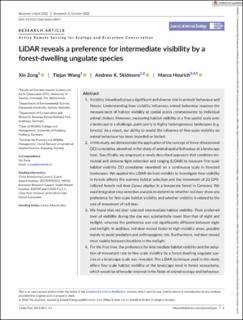| dc.contributor.author | Zong, Xin | |
| dc.contributor.author | Wang, Tiejun | |
| dc.contributor.author | Skidmore, Andrew K. | |
| dc.contributor.author | Heurich, Marco Dietmar | |
| dc.date.accessioned | 2023-01-16T09:48:04Z | |
| dc.date.available | 2023-01-16T09:48:04Z | |
| dc.date.created | 2022-12-16T13:41:39Z | |
| dc.date.issued | 2022 | |
| dc.identifier.citation | Journal of Animal Ecology. 2022, . | en_US |
| dc.identifier.issn | 0021-8790 | |
| dc.identifier.uri | https://hdl.handle.net/11250/3043610 | |
| dc.description | This is an open access article under the terms of the Creative Commons Attribution License, which permits use, distribution and reproduction in any medium, provided the original work is properly cited.
© 2022 The Authors. Journal of Animal Ecology published by John Wiley & Sons Ltd on behalf of British Ecological Society | en_US |
| dc.description.abstract | Abstract 1. Visibility (viewshed) plays a significant and diverse role in animals' behaviour and fitness. Understanding how visibility influences animal behaviour requires the measurement of habitat visibility at spatial scales commensurate to individual animal choices. However, measuring habitat visibility at a fine spatial scale over a landscape is a challenge, particularly in highly heterogeneous landscapes (e.g. forests). As a result, our ability to model the influence of fine-scale visibility on animal behaviour has been impeded or limited. 2. In this study, we demonstrate the application of the concept of three-dimensional (3D) cumulative viewshed in the study of animal spatial behaviour at a landscape level. Specifically, we employed a newly described approach that combines ter-restrial and airborne light detection and ranging (LiDAR) to measure fine-scale habitat visibility (3D cumulative viewshed) on a continuous scale in forested landscapes. We applied the LiDAR-derived visibility to investigate how visibility in forests affects the summer habitat selection and the movement of 20 GPS- collared female red deer Cervus elaphus in a temperate forest in Germany. We used integrated step selection analysis to determine whether red deer show any preference for fine-scale habitat visibility and whether visibility is related to the rate of movement of red deer. 3. We found that red deer selected intermediate habitat visibility. Their preferred level of visibility during the day was substantially lower than that of night and twilight, whereas the preference was not significantly different between night and twilight. In addition, red deer moved faster in high-visibility areas, possibly mainly to avoid predation and anthropogenic risk. Furthermore, red deer moved most rapidly between locations in the twilight. 4. For the first time, the preference for intermediate habitat visibility and the adap-tion of movement rate to fine-scale visibility by a forest-dwelling ungulate spe-cies at a landscape scale was revealed. The LiDAR technique used in this study offers fine-scale habitat visibility at the landscape level in forest ecosystems, which would be of broader interest in the fields of animal ecology and behaviour. | en_US |
| dc.language.iso | eng | en_US |
| dc.rights | Navngivelse 4.0 Internasjonal | * |
| dc.rights.uri | http://creativecommons.org/licenses/by/4.0/deed.no | * |
| dc.subject | fine-scale visibility | en_US |
| dc.subject | habitat selection | en_US |
| dc.subject | integrated step selection analysis | en_US |
| dc.subject | movement rate | en_US |
| dc.subject | red deer | en_US |
| dc.subject | viewshed | en_US |
| dc.title | LiDAR reveals a preference for intermediate visibility by a forest-dwelling ungulate species | en_US |
| dc.type | Peer reviewed | en_US |
| dc.type | Journal article | en_US |
| dc.description.version | publishedVersion | en_US |
| dc.subject.nsi | VDP::Matematikk og Naturvitenskap: 400::Zoologiske og botaniske fag: 480::Økologi: 488 | en_US |
| dc.source.pagenumber | 14 | en_US |
| dc.source.journal | Journal of Animal Ecology | en_US |
| dc.identifier.doi | 10.1111/1365-2656.13847 | |
| dc.identifier.cristin | 2094408 | |
| cristin.ispublished | true | |
| cristin.fulltext | original | |
| cristin.qualitycode | 2 | |

